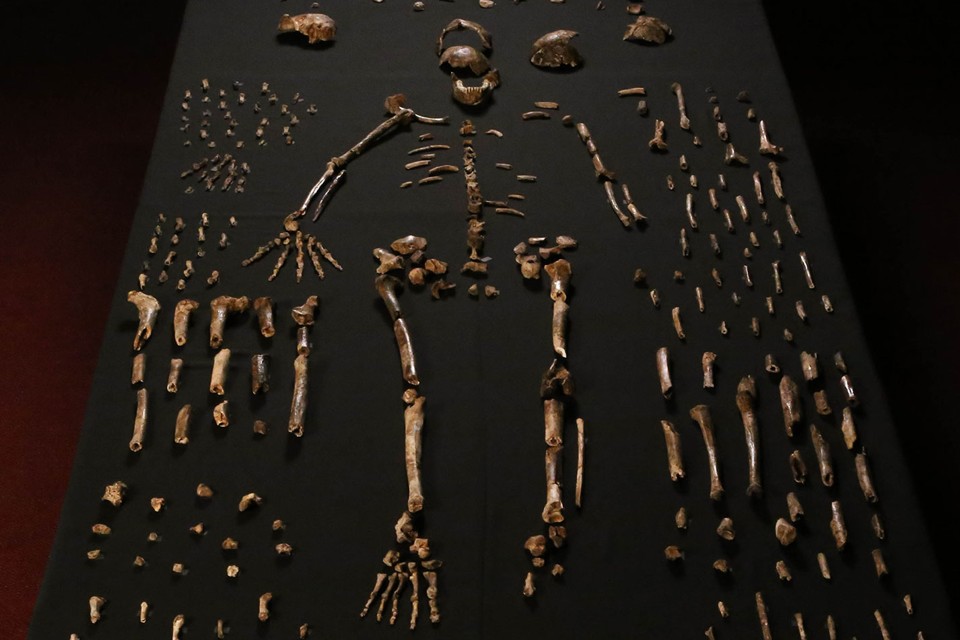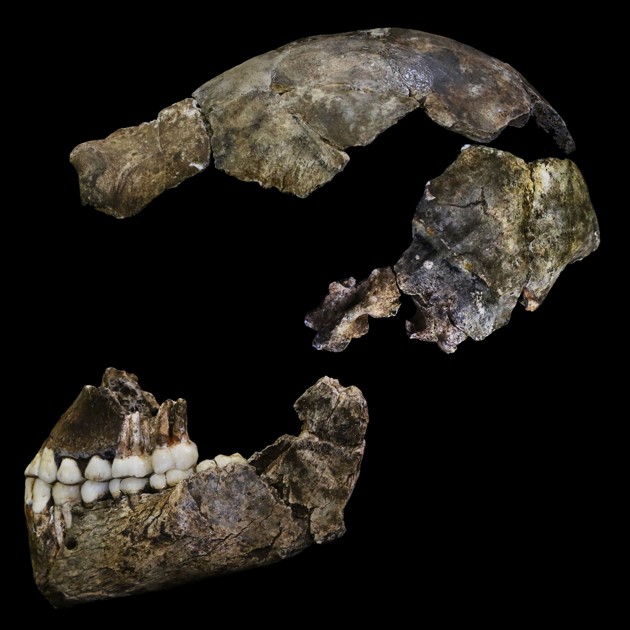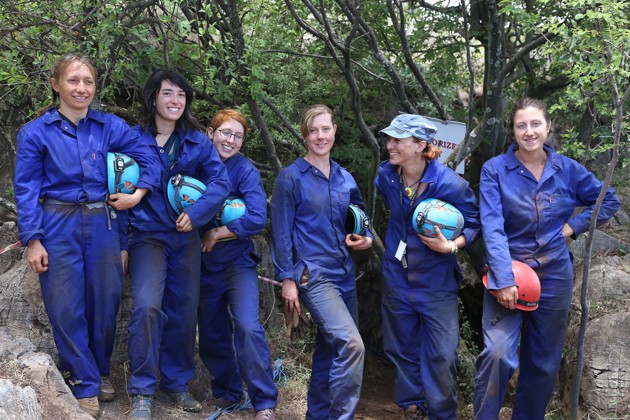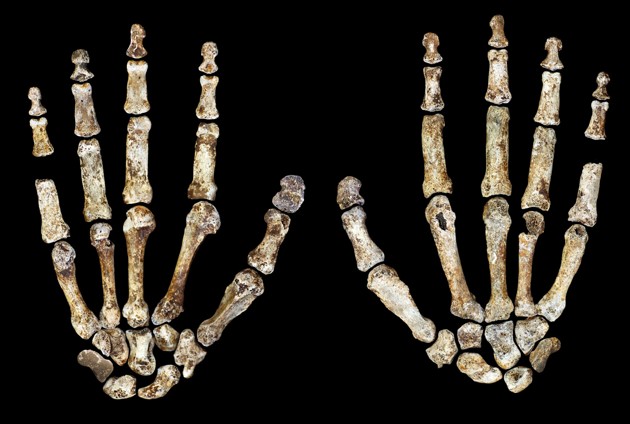6 Tiny Cavers, 15 Odd Skeletons, and 1 Amazing New Species of Ancient Human
SCIENCE
6 Tiny Cavers, 15 Odd Skeletons, and 1 Amazing New Species of Ancient Human
The inside story behind a spectacular new hominin find

“I thought maybe there were three or four people in the world who would fit that criteria,” Berger recalls. “Within a few days, I had 60 applicants, all qualified. I picked six.” They were all women and all skinny—fortunately so, given what happened next. Berger, a palaeoanthropologist at the University of the Witwatersrand, sent them into the Rising Star Cave, and asked them to squeeze themselves through a long vertical chute, which narrowed to a gap just 18 centimeters wide.
This we know because the six women who entered the cave excavated one of the richest collections of hominin fossils ever discovered—some 1,550 fossil fragments, belonging to at least 15 individual skeletons. To find one complete skeleton of a new hominin would be hitting the paleoanthropological jackpot. To find 15, and perhaps more, is like nuking the jackpot from orbit.
In 2008, Berger found one such mosaic in South Africa’s Malapa cave: a new hominin called Australopithecus sediba. He spent the next five years studying it. The project became so all-encompassing that in 2013, Berger, an explorer at heart, realized that he had stopped exploring. To rectify that, he enlisted two cavers, Rick Hunter and Steve Tucker, to explore other South African caves that might yield important fossils. The Rising Star Cave was one of them.
When Berger saw the pictures, he was amazed. He was clearly looking at the skull and jawbone of a hominin, maybe an Australopithecus. “That evening, I couldn’t sleep,” he says. At 2 in the morning, he called Terry Garcia, the National Geographic Society’s chief science and exploration officer, who had funded Berger’s digs before. “If you ever believe in me, believe in me now,” Berger said. “Terry said: Do whatever you need to do.”
Berger quickly rounded up a team of scientists—and six skinny cavers. Marina Elliott was the first and oldest of them on the scene. When she first saw Berger’s ad, she was finishing off a Ph.D. at Simon Fraser University and had already done a lot of fieldwork in Siberia and Alaska. “I was predisposed to extreme environments,” she says. “Telling me that I’d have to do climbing, that it would be underground, and that it would be strange and potentially dangerous… it appealed.” She was joined by five others: Elen Feuerriegel from Australia, and Americans K. Lindsay Eaves, Alia Gurtov, Hannah Morris, and Becca Peixotto.
At the bottom, the team eased down into an area they dubbed the Landing Zone, before entering the fossil-filled trove that they called the 101 Chamber. On the first day, they excavated a single bone—a mandible. “It came out and we said: Wait a minute, this isn’t what we thought,” says Hawks. Tucker’s images hinted at an australopith-like jaw but he had forgotten to include a scale bar. The actual specimen was vastly smaller, and its teeth were almost human-sized. “We thought: We’re looking at something special here.”
On day two, they settled into a rhythm. The six cavers went underground in six-hour shifts, working in claustrophobic darkness and often on all fours. The most challenging part “was the emotional intensity of recovering the fossils themselves,” says Elliott. “There was so much material and it was friable and delicate. And every day, we realized that we were pulling out another 40 or 60 fragments of this thing that was going to be incredible.” Back on the surface other scientists started preparing and cataloguing the fragments. As they unwrapped the packages, “we realised that we had been wrong,” says Berger. “It wasn’t a skeleton. It was more than one.”
These types of multiple individual sites are rare and important for looking at variation, which is after all the thing that evolution works from,” says Susan Antón from New York University, who was not involved in the project. Some other hominins are known only from the most measly of specimens, like small pieces of jaw or finger. “You’re always used to taking a single scrap and working it to death,” says Hawks. “If we only had one piece of Homo naledi, we wouldn’t know anything like the picture we have.”
And then there’s the skull. As I talk to Berger over Skype, he picks one up from his desk. It neatly fits in his hand, as though someone had shrunk the skull of Homo erectus down to the size of Australopithecus.
“By the second morning, we were asking ourselves: What are we looking at here?” says Hawks. The team quickly discounted the idea that they had found several species, since the various copies of any single bone were all the same. Every femur looked like every other femur. H.naledi was clearly a single creature, albeit one with a confusing mish-mash of features. “Everything was just all over the place,” says Berger, whose earlier discovery, A.sediba, also married features from both Australopithecus and Homo. “We were one of the better teams in the world to make this discovery. The idea of mosaicism was drilled into our heads,” says Berger.
It’s tempting to suggest that both species—A.sediba and H.naledi—were intermediate steps on straight evolutionary climb from Australopithecus to ourselves. But these are no “missing links.” Both may be mosaics, but they’re different mosaics. Each has different sets of australopith-like and human-like traits that can’t be easily reconciled on the same family tree.
“If these fossils were three million years old they would tell us something totally different than if they were thirty thousand years old,” adds Carol Ward from the University of Missouri. “Without dates, the fossils reveal almost nothing about hominin evolution, beyond supporting the growing realization that there was much more species diversity than previously thought.”
Hawks is less concerned. “They could be the ancestors of humans. They could be some sort of really primitive creature that lived alongside modern humans,” he says. “To not be able to tell which of those is the case is pretty engaging.”
And their behavior might have been similarly engaging. “We have very strong reason to suspect that H.naledi was doing culturally interesting things, and was doing it with a small brain,” Hawks adds. What kinds of things? “Well, like depositing their bodies in a cave.”
How did all those bodies get in a chamber that is 70 metres from the outside world and many metres down an impossibly tiny crevice?
On the 1,550 pieces of bone, the team couldn’t find a single mark made by a tooth or a stone tool, or any trace of a fracture that happened when the individuals were still alive. “These were the healthiest dead things ever seen,” says Berger. That ruled out cannibals, prehistoric serial killers, or predators that dragged them down into the crevice. The sediment in the chamber also revealed no evidence that water had carried the bodies in from outside. There’s no debris to suggest that the individuals were actually living in the cave. And most tellingly of all, except for a few bones from a bird and some rodents, H.naledi is the only thing in that chamber. “We found nothing else, and the only time you ever find just one thing is when humans deliberately do it,” says Berger.
Was H.naledi really carrying out a burial ritual, despite having a brain no bigger than a gorilla’s? Did they invent the practice independently of our ancestors? “These are going to be great things to explore,” says Berger.
The Rising Star team is now busy trying to describe specific parts of H.naledi’s anatomy, such as its feet, hands, and legs. And they are encouraging other anthropologists to study the fossils, by uploading scans and 3-D models of the fragments to an open database. Eventually, anyone should be able to printH.naledi if they want to.
The team is also actively searching for even more fossil troves in other parts of the Rising Star Cave, as well as other sites. Elliott, one of the skinny cavers who answered Berger’s ad, is now directing the operation on the ground, as well as leading expeditions into other caves.
“Five years went by and we sat in the lab having won the lottery and not going out into the field,” says Berger. “So I say: Buy another ticket. Because it appears that the odds are not that bad.”
Update: This piece originally stated that the australopiths were the earliest hominins; others possibly preceded them, and the text has been slightly altered to reflect that.



No comments:
Post a Comment